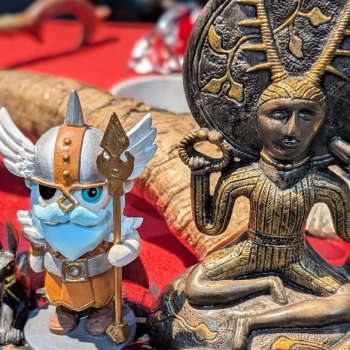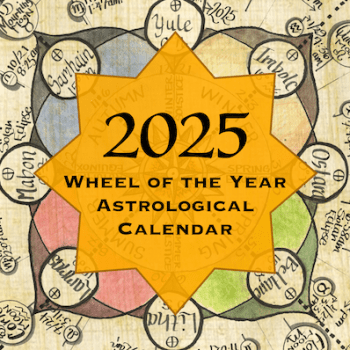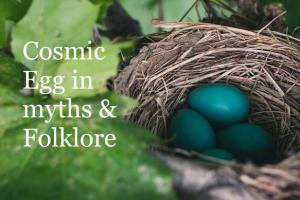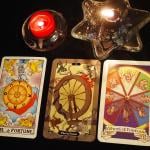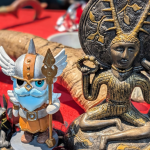[The following is a guest post from Mark Carter. Mark Carter lives, works, and writes in his home town of Bloomington, IL. His works have appeared in The Druid Missal-Any, The Pagan Writer’s Press Yule anthology, and Examiner.com. “Stalking The Goddess” is his first book.]
A few weeks ago I mailed Jason Pitzl-Waters a review copy of my newly released book, “Stalking The Goddess”. I wasn’t sure if it was the sort of thing he’d cover at The Wild Hunt. After all, my book is a study of Robert Graves’s “The White Goddess”, a book which is now 64 years old. This isn’t exactly the sort of current events TWH usually addresses, and I wondered if “Stalking The Goddess” would find an audience with tech-savy Pagans accustomed to gleaning their paganism online rather than from dusty books of their parents’ generation. Could the ghosts of Robert Graves, Gerald Gardner, Margaret Murray, and Sir James Frazer be summoned up one more time, and if they could, did they have anything left to say?
However, TWH was one of the few pagan blogs I visited regularly and, from his occasional references to Graves’s work, I suspected my book would interest him. Jason had once called The White Goddess “Robert Graves’ most controversial book”, reported on suspicions that Graves had stole the book’s thesis from his longtime lover and collaborator, Laura Riding, and even caught Tori Amos’s references to “The White Goddess” on her Night of the Hunters album. The White Goddess still appears in recommended reading lists on various Pagan websites (including Patheos columnist Carl McColman’s 2009 article) and its contributions to Paganism still inspire heated debate. The book has never gone out of print since its initial publication in 1948 and the newest edition, edited by poet and Times Literary Supplement critic Grevel Lindop, is highly recommended. I’ve subscribed to Google Alerts for the search terms “white goddess”, “Robert Graves poet”, and “ogham” and I receive notifications of newly posted material daily.
So, perhaps I had worried for nothing. Perhaps a study of The White Goddess from a pagan perspective isn’t just mildly interesting, but long overdue. As spiritual traditions go, modern paganism is a new phenomenon, but it’s already undergone several phases before developing a self-awareness of its history. The usual reductive formula is Margaret Murray, Robert Graves, and Gerald Gardner; followed by all of those who were directly or indirectly inspired by Gardner. (Doreen Valiente, Ray Buckland, and Alex Sanders are the big players here.) Up to this point, two assumptions were almost always taken for granted: that “paganism” means primarily witchcraft or Wicca, and that Wicca derives from Celtic sources. The 70s brought an explosion of both good and bad books which challenged the assumptions but also muddied the waters of history. It’s not until Adler’s “Drawing Down The Moon” that paganism asks “where did we come from” and “where are we going”? Over the last three decades the above assumptions have been refuted, disproved, and frequently ignored by the glut of Wicca 101 books of the 80s and 90s. The question of how this formula and its assumptions developed is seldom asked. The answers are often found in Graves’s works, and Stalking The Goddess is my attempt to uncover them.
Graves had two passions, literature and history, and he merged them in The White Goddess. The White Goddess speculates upon how druid beliefs might have survived long enough to influence literature and asked how we might recover them. Because of this, most of Graves’s contributions to paganism derive from literature rather than authentic folklore. By scouring old Celtic histories Graves revived a century old debate between Celtic mystics and mainstream historians over the possibility of Druidism’s survival. The White Goddess was the last of the “druidic revival” literature to flaunt conjectures without evidence.
Robert Graves was the inheritor of a long line of forgotten (and dubious) Celtic revivalists like Iolo Morganwg, Edward Davies, and Lewis Spence. He blew the dust off of obscure texts like the Four Ancient Books of Wales and the Myvyrian Archaiology. I suspect the transformation of Ogham from an obscure Irish alphabet to a full blown Celtic tree zodiac is entirely Graves’s doing. If any of these things sound familiar, it’s because Graves rescued them from obscurity and linked them to the coming Pagan movement. Like magic itself, The White Goddess transcends time. It allows readers to apply ancient pagan spirituality to their own future. By merging pagan poetry with pagan history Graves reveals the lost glamor of druidism and medieval mysticism and inspires others to reclaim them for the modern world.
The down side to all this is that paganism received these things almost exclusively through Graves’s personal interpretations rather than as objective history. The Pagan community has been reacting (often times unconsciously) to his claims ever since, and it seems the difference between modern Witches and Druids is whether or not they embrace or reject The White Goddess. “Stalking The Goddess” explores how Graves did all this, who inspired him, who he later inspired, and alternative interpretations of the sources he used. Rather than offering “Stalking The Goddess” as the last word on the subject, I hope it inspires a fresh debate.



